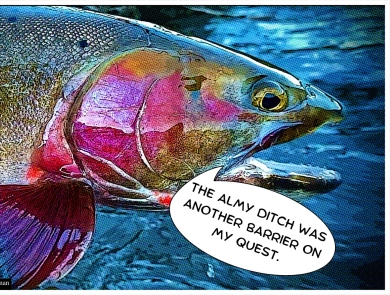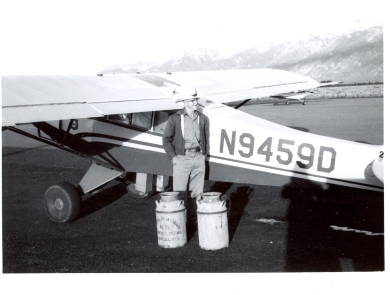About Us
The 2.2-million-acre Wind River Reservation contains some of the most pristine mountainous areas in the lower 48 states as well as over 250 lakes and reservoirs and over 1,100 miles of rivers and streams. From 2000 - 2022, the Service's Partners for Fish and Wildlife Program and the Fish and Aquatic Conservation Program in the Lander Office have collaborated with the Northern Arapaho and Eastern Shoshone Tribes to restore 54,236 sage-steppe acres; 1,721 wetland acres; 26 miles of river systems; and have completed six fish-passage projects.
What We Do
The Reservation provides an abundance of habitat for native cutthroat trout, burbot, and sauger as well as a variety of non-native fish including lake, brown, rainbow and brook trout. Native wildlife such as elk, mule deer, whitetail deer, pronghorn antelope, bighorn sheep and moose are abundant and provide a sustainable harvest for over 1,000 tribal hunters. Additional species of interest include the sage-grouse, peregrine falcon, golden eagle, trumpeter swan, mountain lion, gray wolf, wolverine, and black and grizzly bear.
Our Organization
Our Species
FISH: Native fish species including Yellowstone cutthroat, burbot, and sauger are currently listed as species of concern within Wyoming.
BIRDS: Sage grouse populations have declined by 50 to 80 percent throughout the intermountain west the past decade. Peregrine falcons, ospreys and bald eagles nest on the Wind River Reservation and are surveyed annually. We are currently reintroducing trumpeter swan cygnets as well.
MAMMALS: Currently there are over 10,000 elk that spend the winter on the Wind River Reservation. Over the last 30 years, grizzly bears are now routinely found in the Owl Creek Mountains and are becoming more common in the Wind River Mountains. Wolves are a recent addition to Wind River following the transplant and reintroduction to Yellowstone National Park in 1995.
Projects and Research
The Wind River Indian Reservation, on the eastern slope of the Wind River Mountain Range in west central Wyoming, varies in elevation from less than 5,000 feet in the eastern end to high mountain peaks that approach 13,000 feet in the major ranges-- Wind River, Owl Creek, and Absaroka. Fish & Wildlife resources across this diverse 2,268,000 acre Reservation play an important role in the economy, culture, and daily life of the nearly 15,000 Shoshone and Arapaho Indians living on and near the Reservation. Scientific research and special projects on the Wind River Reservation are used to inform the Wind River Tribal Fish and Game Department and the Inter-Tribal Council who make decisions regarding Fish & Wildlife resource management on the reservation. Conservation of wildlife on Wind River is not only a trust responsibility for the U.S. Fish & Wildlife Service (FWS) but an amazing opportunity to maintain and further wildlife conservation with longstanding Tribal partners on a landscape of 2.2 million acres, equal in size to Yellowstone National Park. As part of the Greater Yellowstone Ecosystem, Wind River is home to a diverse range of wildlife species and plays an important role in the maintenance and recover of some of North America’s most iconic species in one of Americas most recognized ecosystems.
Fishing exploitation study of Burbot on Wind River: Fishing exploitation of burbot in reservation waters was an unknown component of the population dynamics for burbot in the culturally significant burbot fisheries in Bull Lake and the Dinwoody Lakes. Tribal subsistance fishing for burbot is not regulated or tracked making it more difficult to understand the influence of take on the persistance of this culturally significant fishery. This Montana State University lead project indicated that fish exploitation was not currently a significant mortality risk for the Bull Lake burbot fishery or the Dinwoody Lakes fishery.
Yellowstone Cutthroat trout genetic diversity: Cutthroat trout were captured from across the Wind River Reservation as part of a genetic distribution study both on the reservation and across the species geographic range. This cutthroat trout genetic research is lead by researchers from the University of Wyoming and is part of a broader range-wide diversity study that will be used to facilitate the conservation of Yellowstone cutthroat trout across their native range.
Mule Deer migration and population dynamics: U.S. Fish & Wildlife Service biologists Cole Brittain & Dana Shellhorn scan mule deer winter range on the Wind River Reservation to locate GPS collared does and assess fawn survival as part of a larger mule deer migration study lead by the Wyoming Cooperative Fish and Wildlife Research Unit out of the University of Wyoming.
Trumpeter Swan Migration Study: Mark Hogan, Pat Hnilicka, and Bill Long with two Wind River Reservation resident trumpeter swans being tagged and collared to determine migration routes and winter ranges. Trumpeter swans have only recently colonized the Wind River Reservation and little is currently know regarding their migration and habitat use on Wind River.
Get Involved
Partnerships foster creative solutions to challenging situations and often the results are greater than the sum of the parts. Learn more about our local partners.




